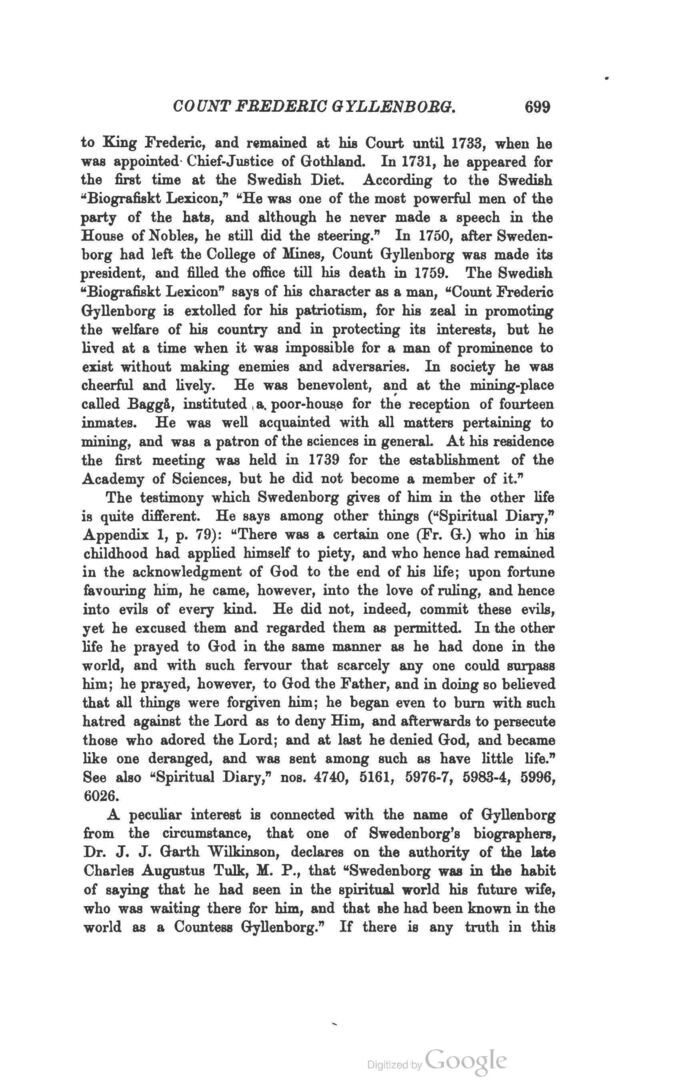
Full resolution (JPEG) - On this page / på denna sida - Sidor ...

<< prev. page << föreg. sida << >> nästa sida >> next page >>
Below is the raw OCR text
from the above scanned image.
Do you see an error? Proofread the page now!
Här nedan syns maskintolkade texten från faksimilbilden ovan.
Ser du något fel? Korrekturläs sidan nu!
This page has never been proofread. / Denna sida har aldrig korrekturlästs.
COUNT FREDERIC GYLLENBORG . 699
to King Frederic, and remained at his Court until 1733, when he
was appointed Chief Justice of Gothland. In 1731, he appeared for
. -
the first time at the Swedish Diet. According to the Swedish
“Biografiskt Lexicon ," "He was one of the most powerful men of the
party of the hats, and although he never made a speech in the
House of Nobles, he still did the steering." In 1750, after Sweden
borg had left the College of Mines, Count Gyllenborg was made its
president, and filled the office till his death in 1759. The Swedish
“Biografiskt Lexicon” says of his character as a man, “ Count Frederic
Gyllenborg is extolled for his patriotism , for his zeal in promoting
the welfare of his country and in protecting its interests, but he
lived at a time when it was impossible for a man of prominence to
exist without making enemies and adversaries. In society he was
cheerful and lively. He was benevolent, and at the mining-place
called Baggå, instituted a poor-house for the reception of fourteen
inmates. He was well acquainted with all matters pertaining to
mining, and was a patron of the sciences in general. At his residence
the first meeting was held in 1739 for the establishment of the
Academy of Sciences, but he did not become a member of it.”
The testimony which Swedenborg gives of him in the other life
is quite different. He says among other things ("Spiritual Diary,"
Appendix 1, p. 79) : "There was a certain one (Fr. G.) who in his
childhood had applied himself to piety, and who hence had remained
in the acknowledgment of God to the end of his life; upon fortune
favouring him , he came, however, into the love of ruling, and hence
into evils of every kind. He did not, indeed, commit these evils,
yet he excused them and regarded them as permitted. In the other
life he prayed to God in the same manner as he had done in the
world, and with such fervour that scarcely any one could surpass
him; he prayed, however, to God the Father, and in doing so believed
that all things were forgiven him; he began even to burn with such
hatred against the Lord as to deny Him, and afterwards to persecute
those who adored the Lord; and at last he denied God, and became
like one deranged, and was sent among such as have little life.”
See also “Spiritual Diary,” nos. 4740, 5161, 5976-7, 5983-4, 5996,
6026.
A peculiar interest is connected with the name of Gyllenborg
from the circumstance, that one of Swedenborg’s biographers,
Dr. J. J. Garth Wilkinson, declares on the authority of the late
Charles Augustus Tulk, M. P., that " Swedenborg was in the habit
of saying that he had seen in the spiritual world his future wife,
who was waiting there for him , and that she had been known in the
world as a Countess Gyllenborg.” If there is any truth in this
<< prev. page << föreg. sida << >> nästa sida >> next page >>